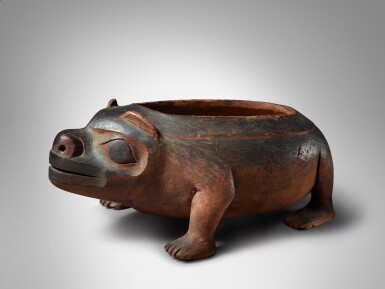
Property from a Private Collection, New Jersey
Tlingit Bear Bowl, Southeast Alaska
Lot Closed
May 18, 07:29 PM GMT
Estimate
8,000 - 12,000 USD
Lot Details
Description
Property from a Private Collection, New Jersey
Tlingit Bear Bowl, Southeast Alaska
Length: 11 in (27.9 cm)
Animal-form dishes are some of the most impressive and captivating objects from the Northwest Coast. Giving life to an otherwise merely functional vessel is one of the great accomplishments of artists from all parts of the coast, and all parts of history, indications that this is an ancient and culturally fulfilling tradition. This example is so well-conceived and refined that one almost expects to see it begin walking along on those short legs.
Feast dishes widely range in size from a few inches to a few feet in length, while generally smaller sizes of similarly sculpted vessels are known and used as oil or ‘grease’ dishes. Grease dishes inevitably show their function by being saturated with the fish or seal oils they once held. This striking vessel exhibits no evidence of oil saturation, and its size as well is somewhat large for a grease dish. It was most likely made to contain the boiled and/or smoked foods served at feasts and other gatherings.
The refined details of the bowl are what elevates this sculpture over many similar vessels of the type. The oval rim of the cavity incorporates a broad band that is slightly hollowed, echoing the wide, undercut rims of many carved or bent-corner bowls made without appending animal features. Without this feature, we would see just a rounded, chubby bear. With it, the animal has become the bowl, bearing the vessel within its body.
The alert, slightly up-tilted head of the bear exhibits great personality in its classically composed form. The large open eyes and ovoid-shaped eyesocket blend smoothly with the rounded nose and nostrils, and along with the wide lips suggest a Tlingit origin.
Steven C. Brown
April, 2021
You May Also Like










